Financial Accounting Report: Principles, Conventions, and Statements
VerifiedAdded on 2021/01/02
|31
|4337
|373
Report
AI Summary
This financial accounting report, prepared for L.V. Audit Kft., provides a comprehensive overview of the subject. It begins by defining financial accounting and its purpose, followed by an examination of relevant regulations, including IASB, IFRS, and GAAP. The report then delves into accounting rules and principles, such as the economic entity assumption, monetary unit assumption, and cost principle. It further explains the concepts of consistency and material disclosure, emphasizing their importance in financial reporting. The report includes practical applications with financial statement analysis for different clients. The report also explains the purpose of preparing bank reconciliation statements, areas which cause records vary with bank records, preparation of accounts through cash flow statements, preparation of sales ledge and purchase ledger accounts and explanation of need for preparing control account. Finally, it concludes with a discussion of the consistency and prudency concepts in accounting.
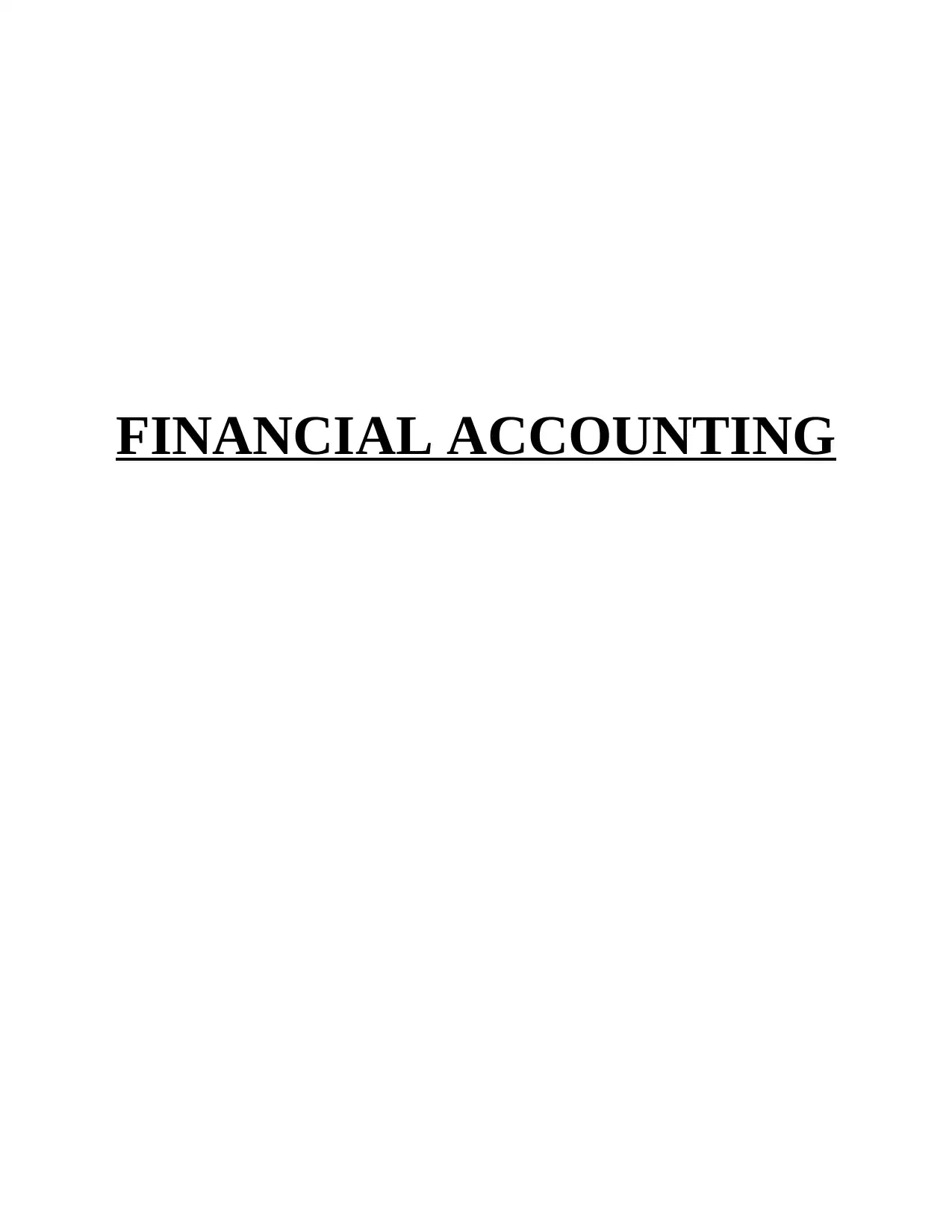
FINANCIAL ACCOUNTING
Paraphrase This Document
Need a fresh take? Get an instant paraphrase of this document with our AI Paraphraser
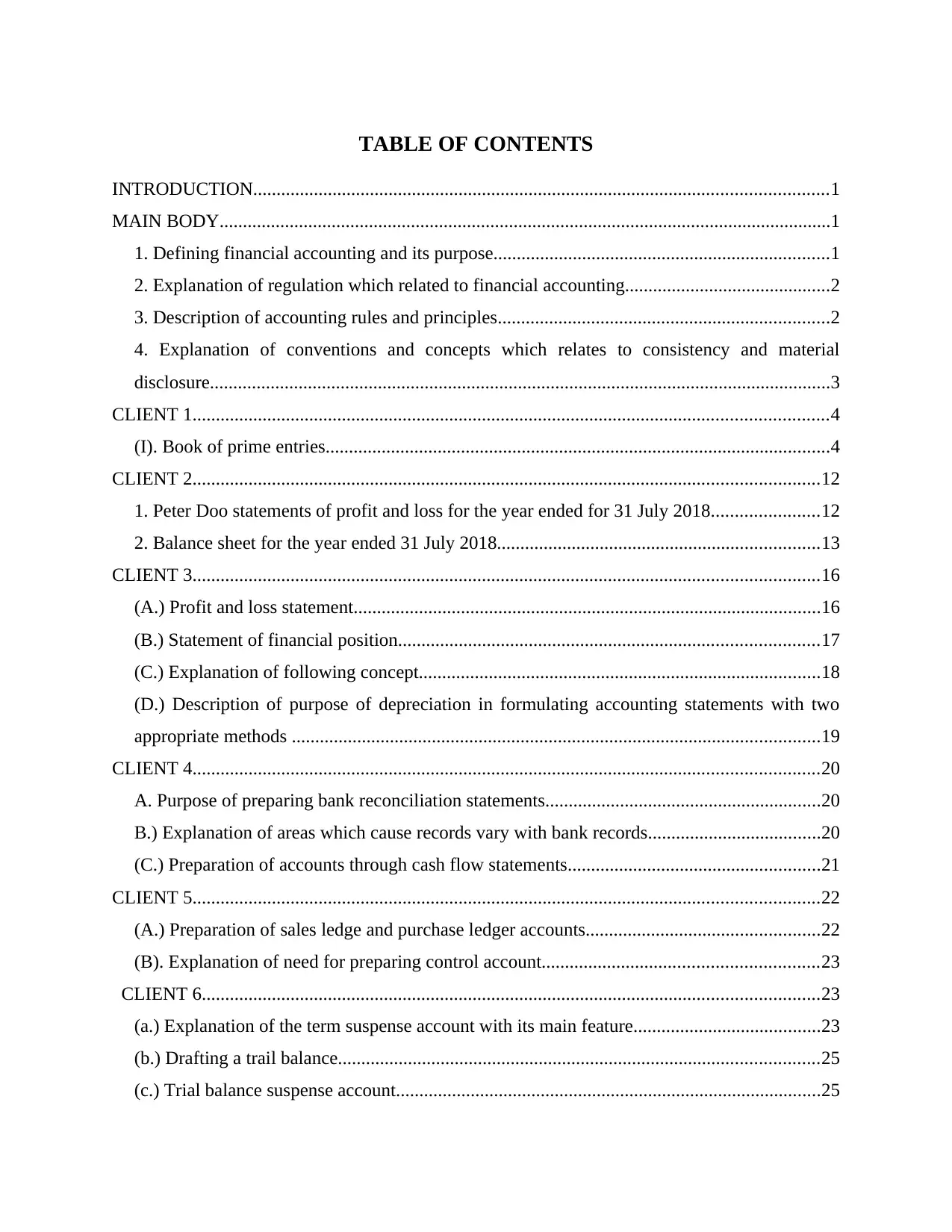
TABLE OF CONTENTS
INTRODUCTION...........................................................................................................................1
MAIN BODY...................................................................................................................................1
1. Defining financial accounting and its purpose........................................................................1
2. Explanation of regulation which related to financial accounting............................................2
3. Description of accounting rules and principles.......................................................................2
4. Explanation of conventions and concepts which relates to consistency and material
disclosure.....................................................................................................................................3
CLIENT 1........................................................................................................................................4
(I). Book of prime entries............................................................................................................4
CLIENT 2......................................................................................................................................12
1. Peter Doo statements of profit and loss for the year ended for 31 July 2018.......................12
2. Balance sheet for the year ended 31 July 2018.....................................................................13
CLIENT 3......................................................................................................................................16
(A.) Profit and loss statement....................................................................................................16
(B.) Statement of financial position..........................................................................................17
(C.) Explanation of following concept......................................................................................18
(D.) Description of purpose of depreciation in formulating accounting statements with two
appropriate methods .................................................................................................................19
CLIENT 4......................................................................................................................................20
A. Purpose of preparing bank reconciliation statements...........................................................20
B.) Explanation of areas which cause records vary with bank records.....................................20
(C.) Preparation of accounts through cash flow statements......................................................21
CLIENT 5......................................................................................................................................22
(A.) Preparation of sales ledge and purchase ledger accounts..................................................22
(B). Explanation of need for preparing control account...........................................................23
CLIENT 6....................................................................................................................................23
(a.) Explanation of the term suspense account with its main feature........................................23
(b.) Drafting a trail balance.......................................................................................................25
(c.) Trial balance suspense account...........................................................................................25
INTRODUCTION...........................................................................................................................1
MAIN BODY...................................................................................................................................1
1. Defining financial accounting and its purpose........................................................................1
2. Explanation of regulation which related to financial accounting............................................2
3. Description of accounting rules and principles.......................................................................2
4. Explanation of conventions and concepts which relates to consistency and material
disclosure.....................................................................................................................................3
CLIENT 1........................................................................................................................................4
(I). Book of prime entries............................................................................................................4
CLIENT 2......................................................................................................................................12
1. Peter Doo statements of profit and loss for the year ended for 31 July 2018.......................12
2. Balance sheet for the year ended 31 July 2018.....................................................................13
CLIENT 3......................................................................................................................................16
(A.) Profit and loss statement....................................................................................................16
(B.) Statement of financial position..........................................................................................17
(C.) Explanation of following concept......................................................................................18
(D.) Description of purpose of depreciation in formulating accounting statements with two
appropriate methods .................................................................................................................19
CLIENT 4......................................................................................................................................20
A. Purpose of preparing bank reconciliation statements...........................................................20
B.) Explanation of areas which cause records vary with bank records.....................................20
(C.) Preparation of accounts through cash flow statements......................................................21
CLIENT 5......................................................................................................................................22
(A.) Preparation of sales ledge and purchase ledger accounts..................................................22
(B). Explanation of need for preparing control account...........................................................23
CLIENT 6....................................................................................................................................23
(a.) Explanation of the term suspense account with its main feature........................................23
(b.) Drafting a trail balance.......................................................................................................25
(c.) Trial balance suspense account...........................................................................................25

(d.) Difference between suspense account and clearing account..............................................25
CONCLUSION .............................................................................................................................26
REFERENCES..............................................................................................................................27
CONCLUSION .............................................................................................................................26
REFERENCES..............................................................................................................................27
⊘ This is a preview!⊘
Do you want full access?
Subscribe today to unlock all pages.

Trusted by 1+ million students worldwide
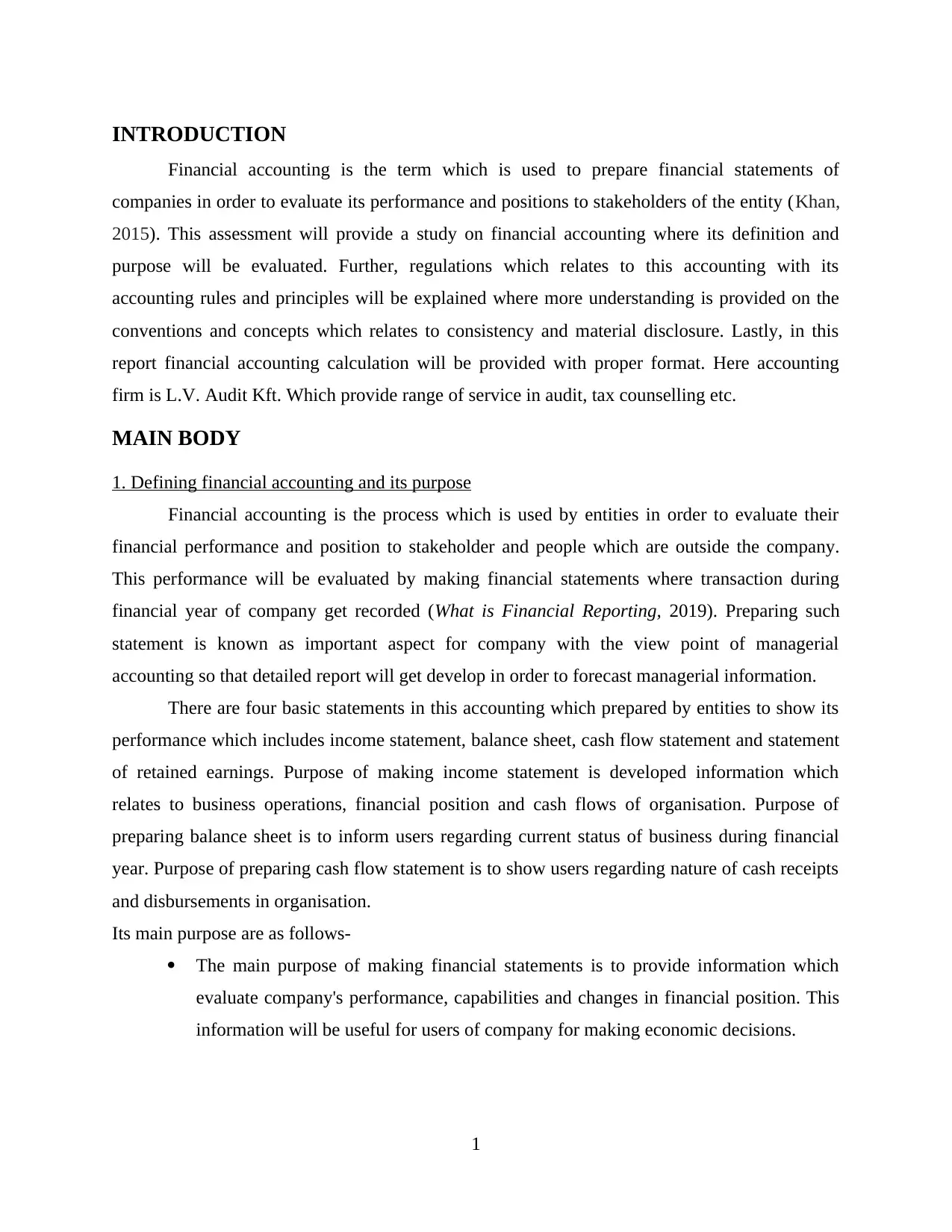
INTRODUCTION
Financial accounting is the term which is used to prepare financial statements of
companies in order to evaluate its performance and positions to stakeholders of the entity (Khan,
2015). This assessment will provide a study on financial accounting where its definition and
purpose will be evaluated. Further, regulations which relates to this accounting with its
accounting rules and principles will be explained where more understanding is provided on the
conventions and concepts which relates to consistency and material disclosure. Lastly, in this
report financial accounting calculation will be provided with proper format. Here accounting
firm is L.V. Audit Kft. Which provide range of service in audit, tax counselling etc.
MAIN BODY
1. Defining financial accounting and its purpose
Financial accounting is the process which is used by entities in order to evaluate their
financial performance and position to stakeholder and people which are outside the company.
This performance will be evaluated by making financial statements where transaction during
financial year of company get recorded (What is Financial Reporting, 2019). Preparing such
statement is known as important aspect for company with the view point of managerial
accounting so that detailed report will get develop in order to forecast managerial information.
There are four basic statements in this accounting which prepared by entities to show its
performance which includes income statement, balance sheet, cash flow statement and statement
of retained earnings. Purpose of making income statement is developed information which
relates to business operations, financial position and cash flows of organisation. Purpose of
preparing balance sheet is to inform users regarding current status of business during financial
year. Purpose of preparing cash flow statement is to show users regarding nature of cash receipts
and disbursements in organisation.
Its main purpose are as follows-
The main purpose of making financial statements is to provide information which
evaluate company's performance, capabilities and changes in financial position. This
information will be useful for users of company for making economic decisions.
1
Financial accounting is the term which is used to prepare financial statements of
companies in order to evaluate its performance and positions to stakeholders of the entity (Khan,
2015). This assessment will provide a study on financial accounting where its definition and
purpose will be evaluated. Further, regulations which relates to this accounting with its
accounting rules and principles will be explained where more understanding is provided on the
conventions and concepts which relates to consistency and material disclosure. Lastly, in this
report financial accounting calculation will be provided with proper format. Here accounting
firm is L.V. Audit Kft. Which provide range of service in audit, tax counselling etc.
MAIN BODY
1. Defining financial accounting and its purpose
Financial accounting is the process which is used by entities in order to evaluate their
financial performance and position to stakeholder and people which are outside the company.
This performance will be evaluated by making financial statements where transaction during
financial year of company get recorded (What is Financial Reporting, 2019). Preparing such
statement is known as important aspect for company with the view point of managerial
accounting so that detailed report will get develop in order to forecast managerial information.
There are four basic statements in this accounting which prepared by entities to show its
performance which includes income statement, balance sheet, cash flow statement and statement
of retained earnings. Purpose of making income statement is developed information which
relates to business operations, financial position and cash flows of organisation. Purpose of
preparing balance sheet is to inform users regarding current status of business during financial
year. Purpose of preparing cash flow statement is to show users regarding nature of cash receipts
and disbursements in organisation.
Its main purpose are as follows-
The main purpose of making financial statements is to provide information which
evaluate company's performance, capabilities and changes in financial position. This
information will be useful for users of company for making economic decisions.
1
Paraphrase This Document
Need a fresh take? Get an instant paraphrase of this document with our AI Paraphraser
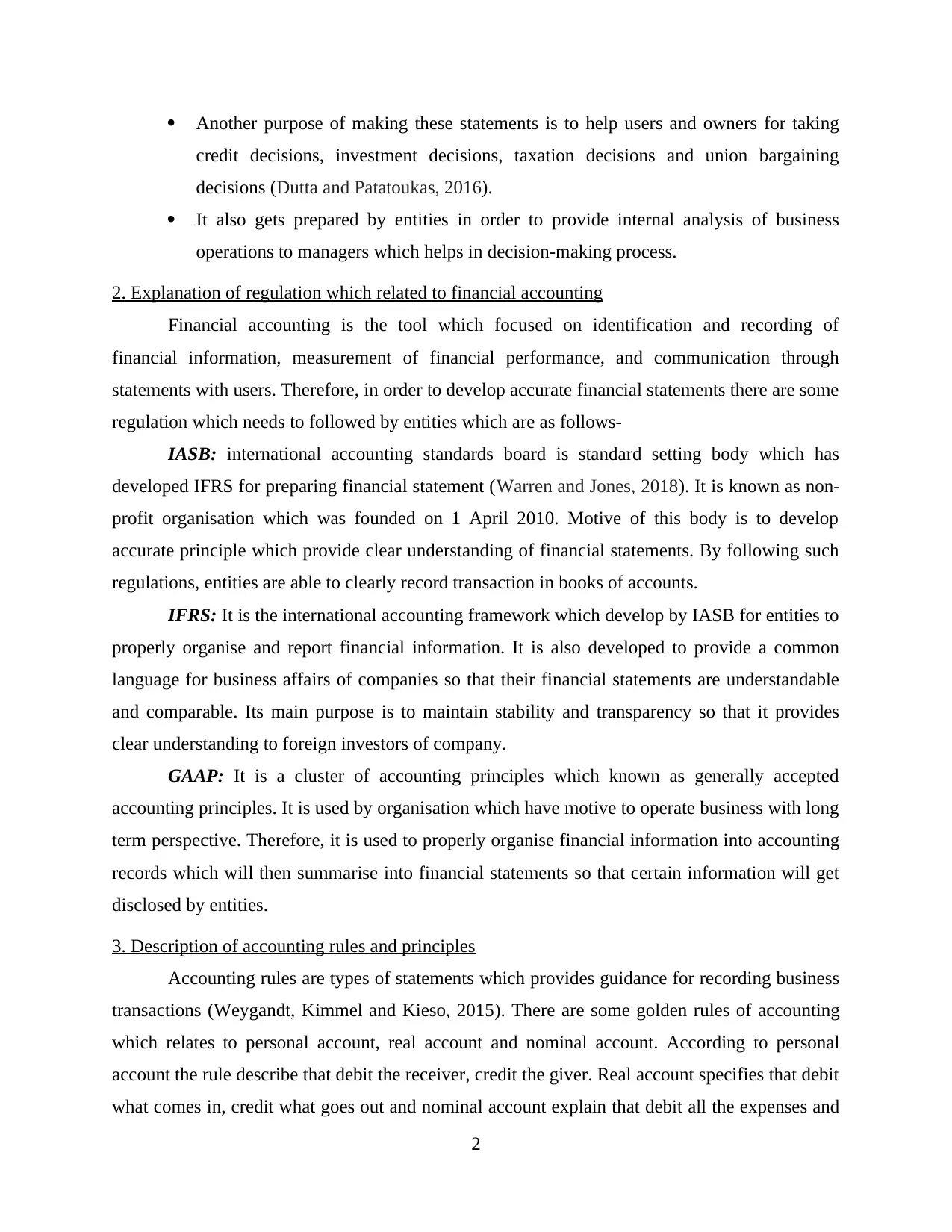
Another purpose of making these statements is to help users and owners for taking
credit decisions, investment decisions, taxation decisions and union bargaining
decisions (Dutta and Patatoukas, 2016).
It also gets prepared by entities in order to provide internal analysis of business
operations to managers which helps in decision-making process.
2. Explanation of regulation which related to financial accounting
Financial accounting is the tool which focused on identification and recording of
financial information, measurement of financial performance, and communication through
statements with users. Therefore, in order to develop accurate financial statements there are some
regulation which needs to followed by entities which are as follows-
IASB: international accounting standards board is standard setting body which has
developed IFRS for preparing financial statement (Warren and Jones, 2018). It is known as non-
profit organisation which was founded on 1 April 2010. Motive of this body is to develop
accurate principle which provide clear understanding of financial statements. By following such
regulations, entities are able to clearly record transaction in books of accounts.
IFRS: It is the international accounting framework which develop by IASB for entities to
properly organise and report financial information. It is also developed to provide a common
language for business affairs of companies so that their financial statements are understandable
and comparable. Its main purpose is to maintain stability and transparency so that it provides
clear understanding to foreign investors of company.
GAAP: It is a cluster of accounting principles which known as generally accepted
accounting principles. It is used by organisation which have motive to operate business with long
term perspective. Therefore, it is used to properly organise financial information into accounting
records which will then summarise into financial statements so that certain information will get
disclosed by entities.
3. Description of accounting rules and principles
Accounting rules are types of statements which provides guidance for recording business
transactions (Weygandt, Kimmel and Kieso, 2015). There are some golden rules of accounting
which relates to personal account, real account and nominal account. According to personal
account the rule describe that debit the receiver, credit the giver. Real account specifies that debit
what comes in, credit what goes out and nominal account explain that debit all the expenses and
2
credit decisions, investment decisions, taxation decisions and union bargaining
decisions (Dutta and Patatoukas, 2016).
It also gets prepared by entities in order to provide internal analysis of business
operations to managers which helps in decision-making process.
2. Explanation of regulation which related to financial accounting
Financial accounting is the tool which focused on identification and recording of
financial information, measurement of financial performance, and communication through
statements with users. Therefore, in order to develop accurate financial statements there are some
regulation which needs to followed by entities which are as follows-
IASB: international accounting standards board is standard setting body which has
developed IFRS for preparing financial statement (Warren and Jones, 2018). It is known as non-
profit organisation which was founded on 1 April 2010. Motive of this body is to develop
accurate principle which provide clear understanding of financial statements. By following such
regulations, entities are able to clearly record transaction in books of accounts.
IFRS: It is the international accounting framework which develop by IASB for entities to
properly organise and report financial information. It is also developed to provide a common
language for business affairs of companies so that their financial statements are understandable
and comparable. Its main purpose is to maintain stability and transparency so that it provides
clear understanding to foreign investors of company.
GAAP: It is a cluster of accounting principles which known as generally accepted
accounting principles. It is used by organisation which have motive to operate business with long
term perspective. Therefore, it is used to properly organise financial information into accounting
records which will then summarise into financial statements so that certain information will get
disclosed by entities.
3. Description of accounting rules and principles
Accounting rules are types of statements which provides guidance for recording business
transactions (Weygandt, Kimmel and Kieso, 2015). There are some golden rules of accounting
which relates to personal account, real account and nominal account. According to personal
account the rule describe that debit the receiver, credit the giver. Real account specifies that debit
what comes in, credit what goes out and nominal account explain that debit all the expenses and
2
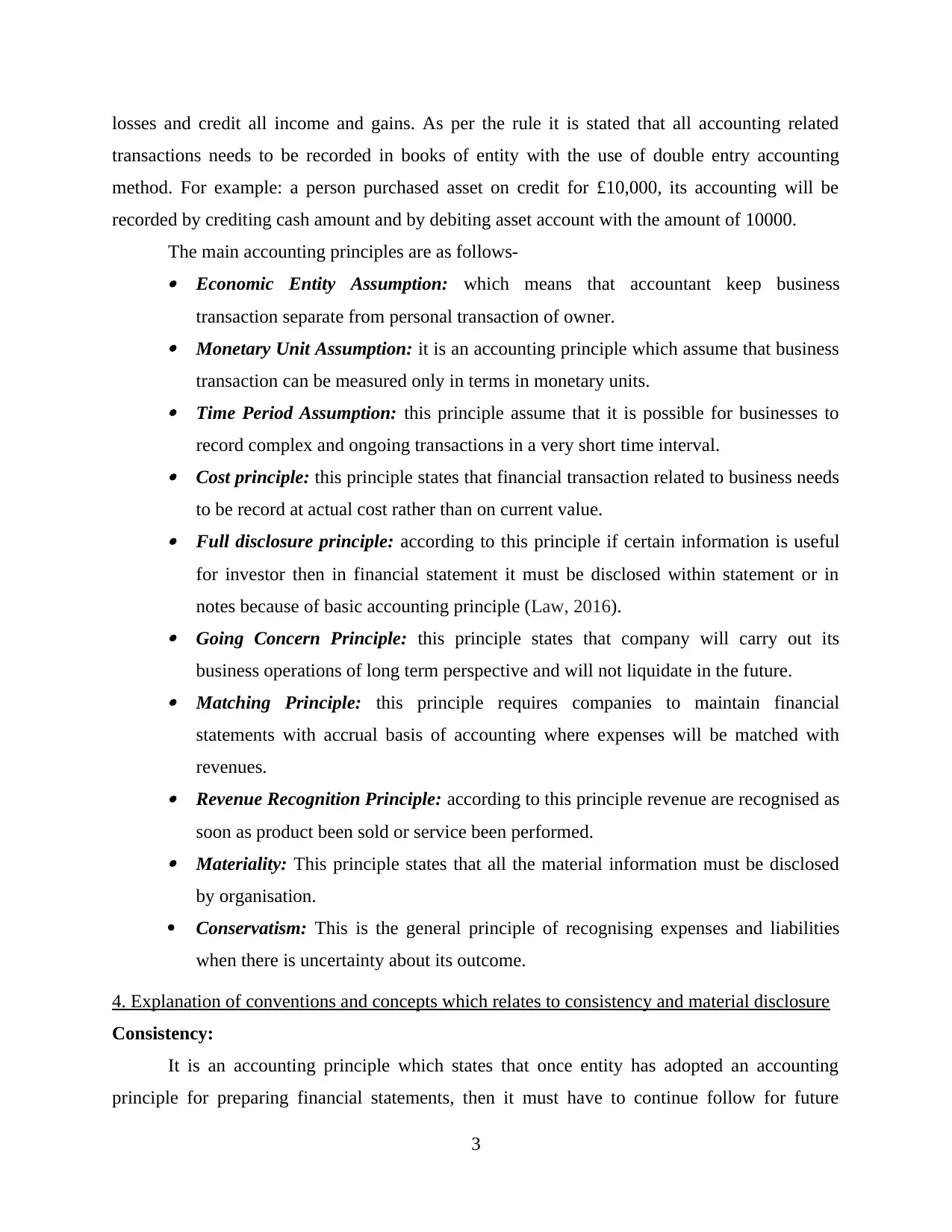
losses and credit all income and gains. As per the rule it is stated that all accounting related
transactions needs to be recorded in books of entity with the use of double entry accounting
method. For example: a person purchased asset on credit for £10,000, its accounting will be
recorded by crediting cash amount and by debiting asset account with the amount of 10000.
The main accounting principles are as follows-
Economic Entity Assumption: which means that accountant keep business
transaction separate from personal transaction of owner.
Monetary Unit Assumption: it is an accounting principle which assume that business
transaction can be measured only in terms in monetary units.
Time Period Assumption: this principle assume that it is possible for businesses to
record complex and ongoing transactions in a very short time interval.
Cost principle: this principle states that financial transaction related to business needs
to be record at actual cost rather than on current value.
Full disclosure principle: according to this principle if certain information is useful
for investor then in financial statement it must be disclosed within statement or in
notes because of basic accounting principle (Law, 2016).
Going Concern Principle: this principle states that company will carry out its
business operations of long term perspective and will not liquidate in the future.
Matching Principle: this principle requires companies to maintain financial
statements with accrual basis of accounting where expenses will be matched with
revenues.
Revenue Recognition Principle: according to this principle revenue are recognised as
soon as product been sold or service been performed.
Materiality: This principle states that all the material information must be disclosed
by organisation.
Conservatism: This is the general principle of recognising expenses and liabilities
when there is uncertainty about its outcome.
4. Explanation of conventions and concepts which relates to consistency and material disclosure
Consistency:
It is an accounting principle which states that once entity has adopted an accounting
principle for preparing financial statements, then it must have to continue follow for future
3
transactions needs to be recorded in books of entity with the use of double entry accounting
method. For example: a person purchased asset on credit for £10,000, its accounting will be
recorded by crediting cash amount and by debiting asset account with the amount of 10000.
The main accounting principles are as follows-
Economic Entity Assumption: which means that accountant keep business
transaction separate from personal transaction of owner.
Monetary Unit Assumption: it is an accounting principle which assume that business
transaction can be measured only in terms in monetary units.
Time Period Assumption: this principle assume that it is possible for businesses to
record complex and ongoing transactions in a very short time interval.
Cost principle: this principle states that financial transaction related to business needs
to be record at actual cost rather than on current value.
Full disclosure principle: according to this principle if certain information is useful
for investor then in financial statement it must be disclosed within statement or in
notes because of basic accounting principle (Law, 2016).
Going Concern Principle: this principle states that company will carry out its
business operations of long term perspective and will not liquidate in the future.
Matching Principle: this principle requires companies to maintain financial
statements with accrual basis of accounting where expenses will be matched with
revenues.
Revenue Recognition Principle: according to this principle revenue are recognised as
soon as product been sold or service been performed.
Materiality: This principle states that all the material information must be disclosed
by organisation.
Conservatism: This is the general principle of recognising expenses and liabilities
when there is uncertainty about its outcome.
4. Explanation of conventions and concepts which relates to consistency and material disclosure
Consistency:
It is an accounting principle which states that once entity has adopted an accounting
principle for preparing financial statements, then it must have to continue follow for future
3
⊘ This is a preview!⊘
Do you want full access?
Subscribe today to unlock all pages.

Trusted by 1+ million students worldwide
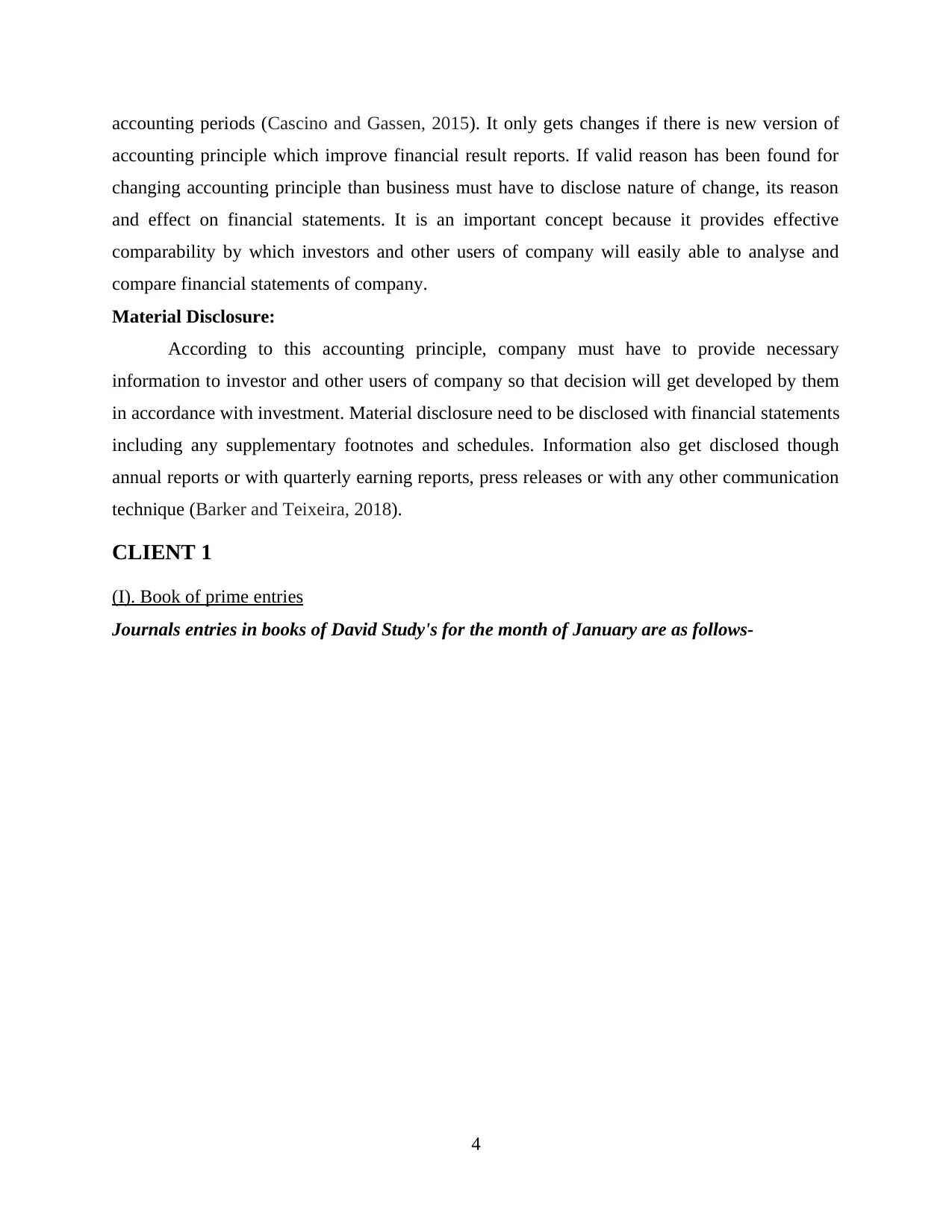
accounting periods (Cascino and Gassen, 2015). It only gets changes if there is new version of
accounting principle which improve financial result reports. If valid reason has been found for
changing accounting principle than business must have to disclose nature of change, its reason
and effect on financial statements. It is an important concept because it provides effective
comparability by which investors and other users of company will easily able to analyse and
compare financial statements of company.
Material Disclosure:
According to this accounting principle, company must have to provide necessary
information to investor and other users of company so that decision will get developed by them
in accordance with investment. Material disclosure need to be disclosed with financial statements
including any supplementary footnotes and schedules. Information also get disclosed though
annual reports or with quarterly earning reports, press releases or with any other communication
technique (Barker and Teixeira, 2018).
CLIENT 1
(I). Book of prime entries
Journals entries in books of David Study's for the month of January are as follows-
4
accounting principle which improve financial result reports. If valid reason has been found for
changing accounting principle than business must have to disclose nature of change, its reason
and effect on financial statements. It is an important concept because it provides effective
comparability by which investors and other users of company will easily able to analyse and
compare financial statements of company.
Material Disclosure:
According to this accounting principle, company must have to provide necessary
information to investor and other users of company so that decision will get developed by them
in accordance with investment. Material disclosure need to be disclosed with financial statements
including any supplementary footnotes and schedules. Information also get disclosed though
annual reports or with quarterly earning reports, press releases or with any other communication
technique (Barker and Teixeira, 2018).
CLIENT 1
(I). Book of prime entries
Journals entries in books of David Study's for the month of January are as follows-
4
Paraphrase This Document
Need a fresh take? Get an instant paraphrase of this document with our AI Paraphraser
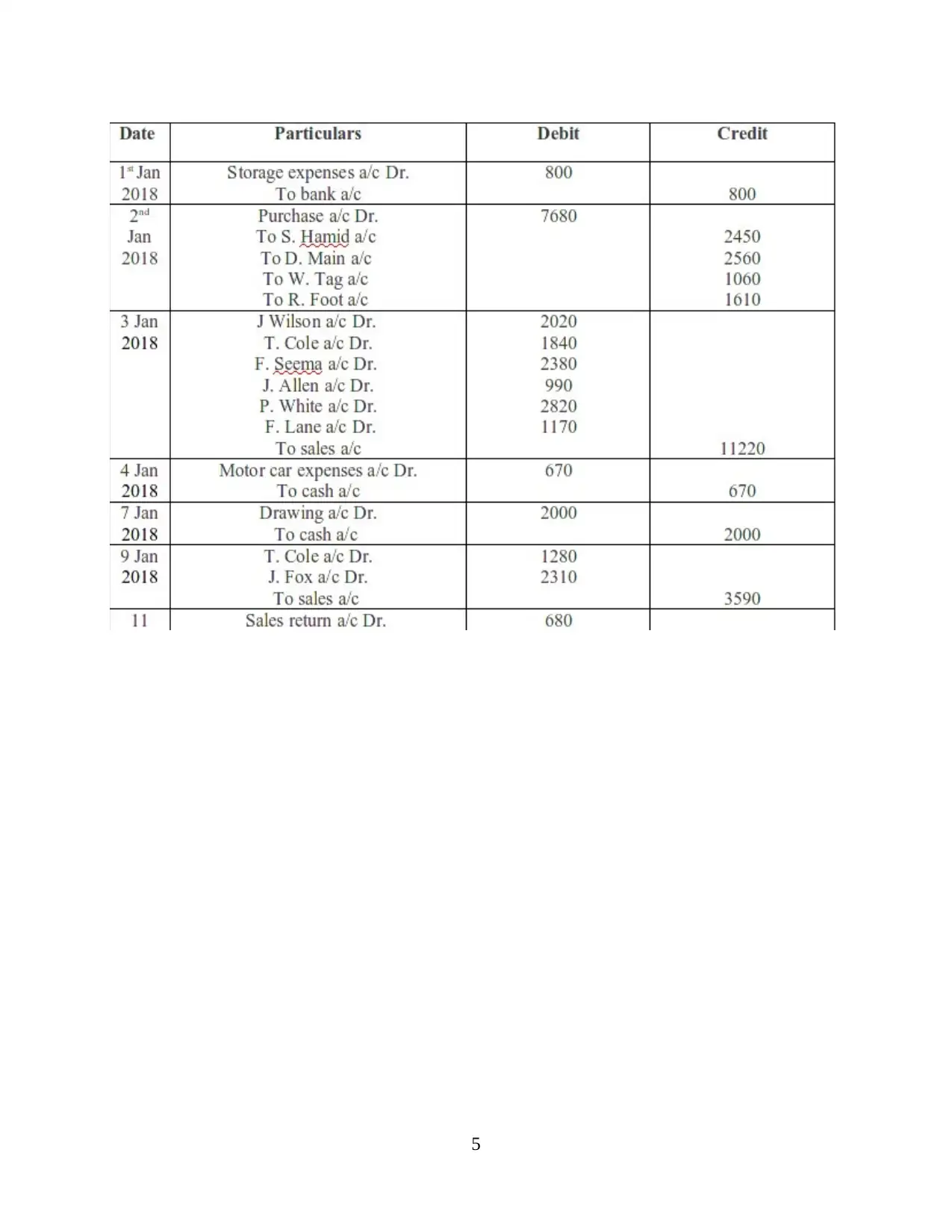
5
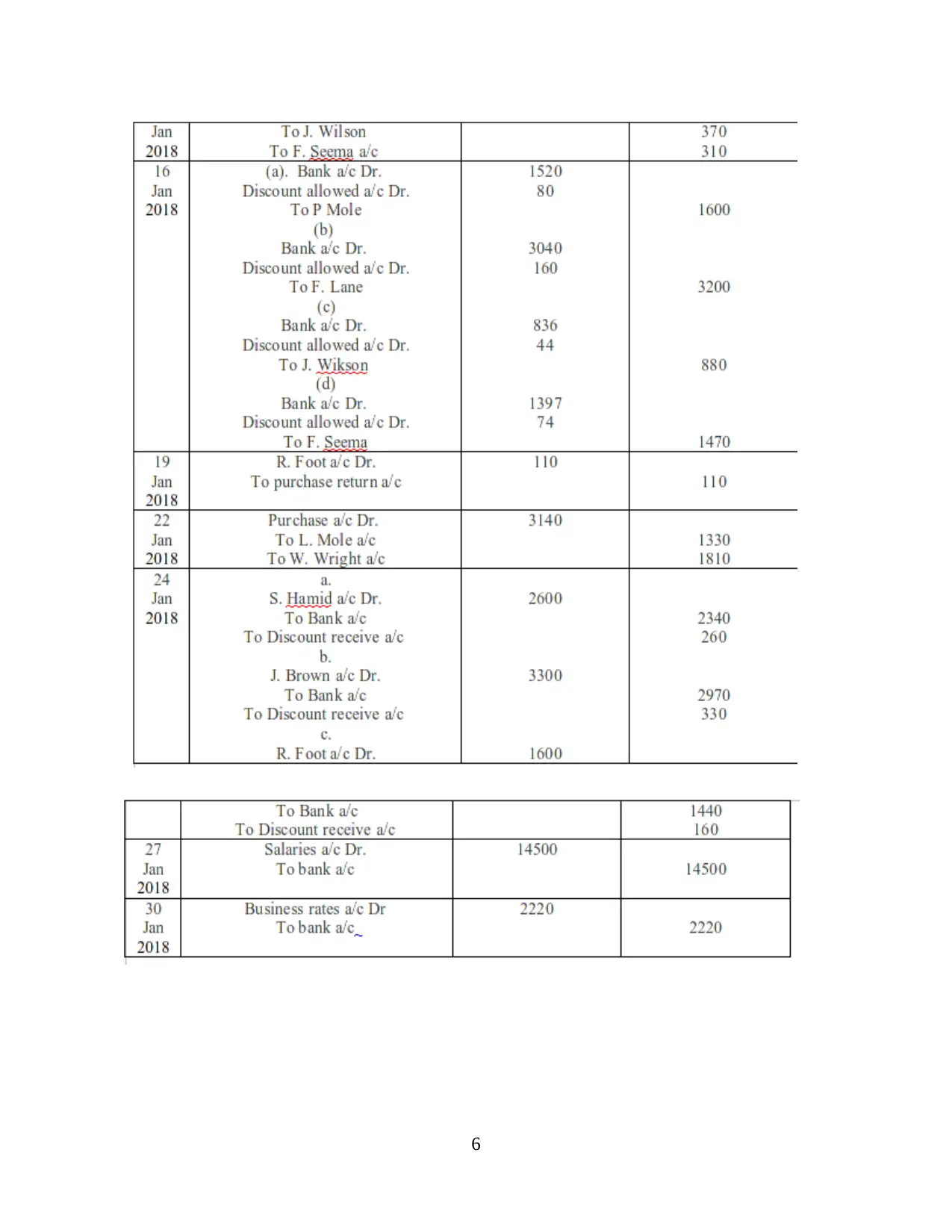
6
⊘ This is a preview!⊘
Do you want full access?
Subscribe today to unlock all pages.

Trusted by 1+ million students worldwide
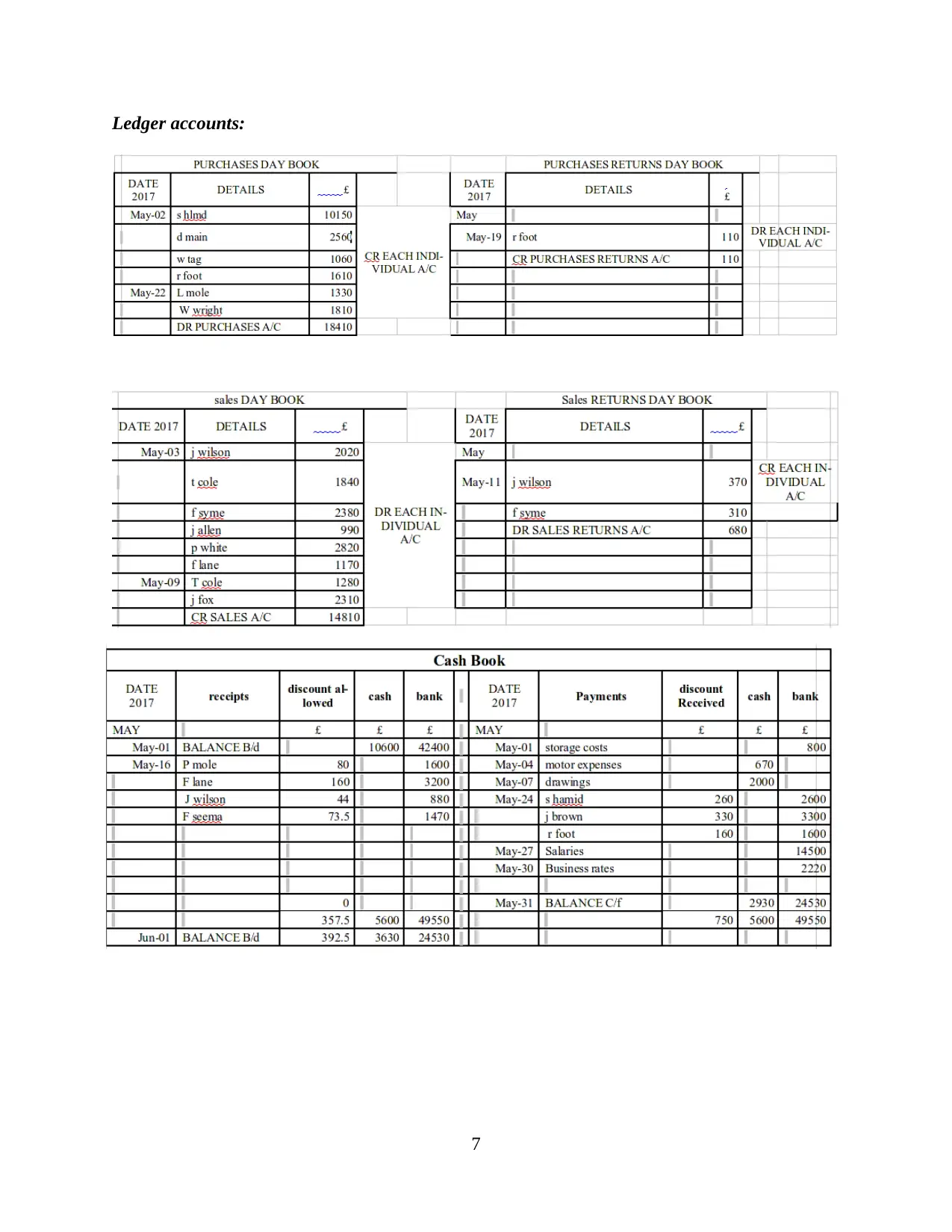
Ledger accounts:
7
7
Paraphrase This Document
Need a fresh take? Get an instant paraphrase of this document with our AI Paraphraser
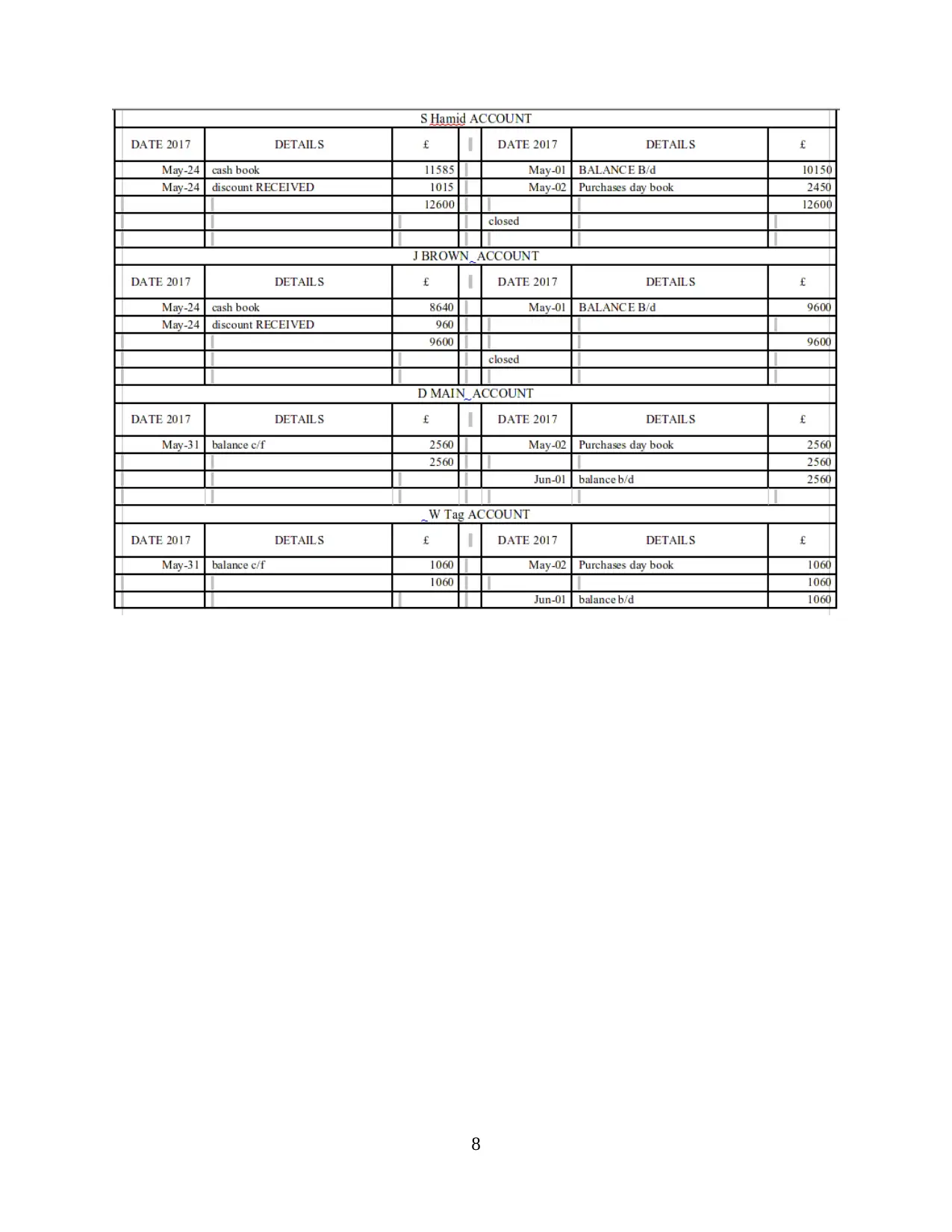
8
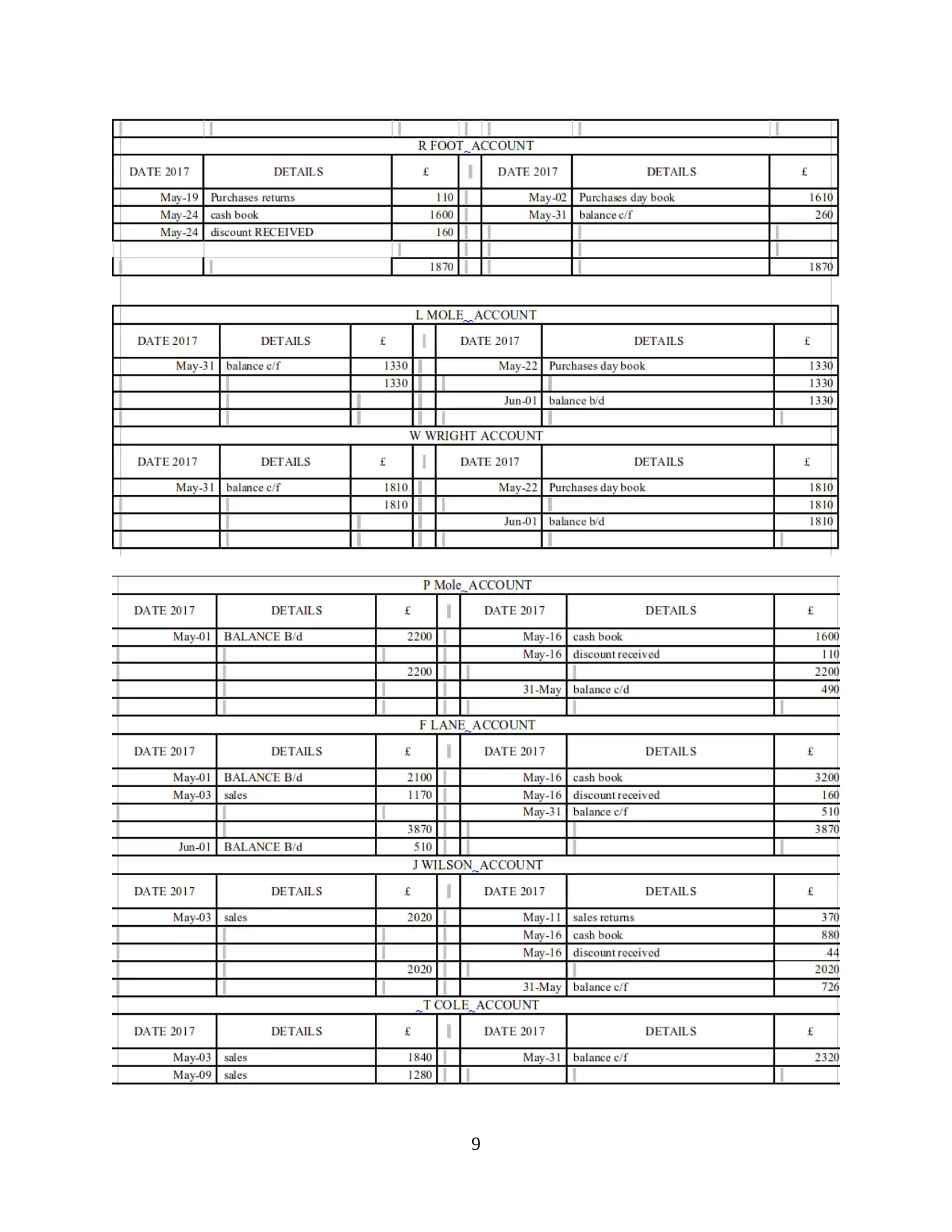
9
⊘ This is a preview!⊘
Do you want full access?
Subscribe today to unlock all pages.

Trusted by 1+ million students worldwide
1 out of 31
Related Documents
Your All-in-One AI-Powered Toolkit for Academic Success.
+13062052269
info@desklib.com
Available 24*7 on WhatsApp / Email
![[object Object]](/_next/static/media/star-bottom.7253800d.svg)
Unlock your academic potential
Copyright © 2020–2025 A2Z Services. All Rights Reserved. Developed and managed by ZUCOL.





